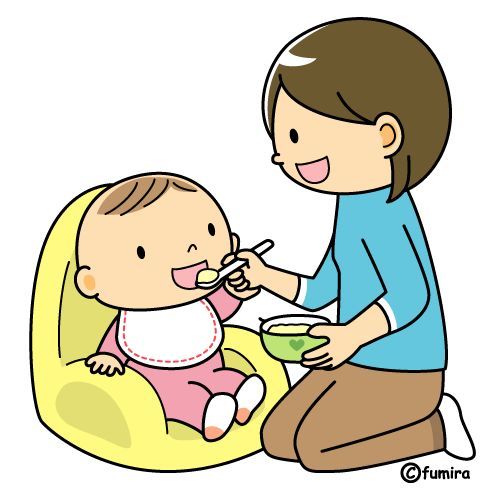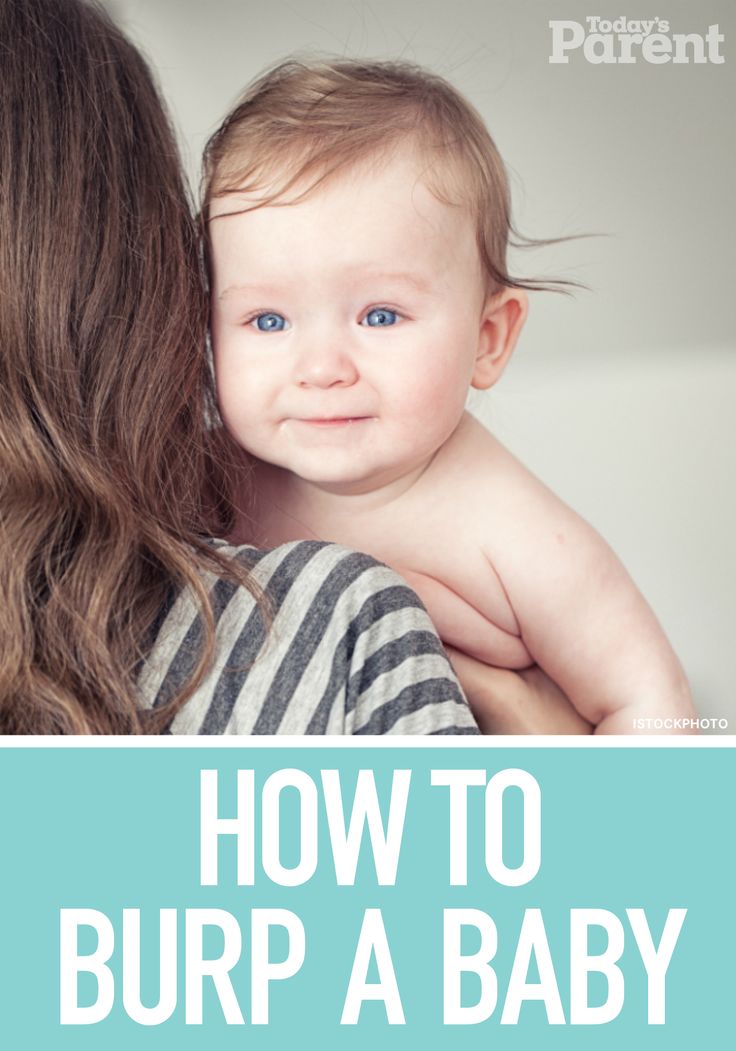7 month old baby food quantity
7-Month-Old Baby: Your Questions Answered
7-Month-Old Baby
Your baby is 7 months old! As your little one is now more active, you’ve got to get your home ready. We know you probably childproofed when baby first came home, but having a mini mover and shaker changes everything. Get down on your hands and knees to see what hazards are around that you'll need to guard against. That includes anything baby could tumble over, bump into, get cut or pinched on or get tangled in. Also, make sure anything that could fall onto your child (a dresser, a bookshelf, the TV) is securely strapped into place, and be cautious to keep all choking hazards out of reach—that includes looking for small things that could easily drop on the floor unnoticed, like coins.
As your 7-month-old baby gets stronger and smarter every day, you may find yourself with a whole new slew of questions and concerns. What can a 7-month-old see? What can you give a 7-month-old for meals? Should you be worried if your 7-month-old doesn’t have teeth yet?
To help you navigate and prepare for the seven-month mark, we’re sharing a guide with all the 7-month-old baby milestones. From sleeping schedules to eating routines to fun activity ideas, here’s the intel you need to ensure your 7-month-old baby is on a happy and healthy track.
In this article:
7-month-old development
7-month-old health
7-month-old baby food
7-month-old sleep
7-month-old schedule
Activities for a 7-month-old
7-month-old checklist and tips
7-Month-Old Development
In the last three months, baby’s probably grown about 2 inches and their head circumference may have grown about an inch. They’re still developing their senses and skills that will lead to more independence.
7-month-old baby weight and length
Typically, how much does a 7-month-old weigh—or, rather, how much should a 7-month-old weigh? Average weight of a 7-month old is 16.8 pounds for girls and 18.3 pounds for boys. Average length is 26.5 inches for girls and 27.2 inches for boys, according to the World Health Organization.
But don’t get too caught up with the “normal” weight of a 7-month-old baby. Height and weight can vary widely between healthy babies, so as long as your baby is growing at a healthy rate—on a steady upward curve on the chart at the doctor’s office—and the pediatrician doesn’t see any signs of a problem, your baby’s growth is right on track.
Height and weight can vary widely between healthy babies, so as long as your baby is growing at a healthy rate—on a steady upward curve on the chart at the doctor’s office—and the pediatrician doesn’t see any signs of a problem, your baby’s growth is right on track.
7-month-old’s five senses
- What can babies see at 7-months-old? A lot! Baby’s distance vision is improving every day. And they can see everything in full color now.
- The parts of baby’s brain dealing with sound processing have developed, which means baby can fully process and understand a range of sounds.
- Baby’s been listening to your voice and may try to copy the pattern and tones of your voice when they babble. So chatty!
7-month-old baby milestones
What should a 7-month-old be able to do? Remember, all babies develop at their own rate, but this is a peek at what might be happening with your baby this month.
- Baby might be able to sit up without any help, though they might have to keep their hands on the floor to stay upright.
 If they haven't already started crawling, keep an eye out this month. Many babies start making moves as early as 6 or 7 months. However, if they’re not scooting around just yet, don’t worry. They’ll strengthen those muscles and get moving on their own time. And, FYI, some babies skip crawling and go straight to walking.
If they haven't already started crawling, keep an eye out this month. Many babies start making moves as early as 6 or 7 months. However, if they’re not scooting around just yet, don’t worry. They’ll strengthen those muscles and get moving on their own time. And, FYI, some babies skip crawling and go straight to walking. - Baby is starting to work on fine-tuning their grasp. Now, baby probably picks things up with their whole hand, but they’ll also soon start working on the “pincer grasp,” where they’ll pick things up with their pointer finger and thumb.
- Baby bears weight on their legs when you hold them upright, and might even start to jump up and down in this position.
- Baby babbles and imitates sounds. They know what things to do to attract your attention (and isn’t it adorable?).
7-Month-Old Health
Click through for answers to some of 7-month-olds’ parents’ biggest health questions:
7-month-old teething
Got teeth? If your 7-month-old is still all gums, know that some pearly whites will probably pop up pretty soon. Typically, the bottom incisors are the first two to make an appearance followed by the top incisors.
Typically, the bottom incisors are the first two to make an appearance followed by the top incisors.
7-Month-Old Baby Feeding
Seven-month-old babies are eating some solid foods, but their main source of nutrition is still breast milk or formula.
How much should a 7-month-old eat, and how often?
- Bottle feeding: How much formula for a 7-month-old baby? They should be drinking about six to eight ounces of formula, four to six times per day.
- Breastfeeding: Seven-month-olds still typically nurse about every three or four hours.
- Pumping: If you’re pumping, baby needs a total of about 25 ounces of breast milk per day. So you’ll need to divide that by how many feedings your baby typically has. For example, if you feed baby about six times per day, they should get about 4.2 ounces of breast milk at each feeding.
- Solid food: How much solid food for a 7-month-old? Baby should be starting to get three meals of solid food each day.
 Depending on the baby, a meal might be as little as a tablespoon or two or as much as four to six ounces (eight to 12 tablespoons) of baby food.
Depending on the baby, a meal might be as little as a tablespoon or two or as much as four to six ounces (eight to 12 tablespoons) of baby food.
What can a 7-month-old eat?
What to feed your 7-month-old baby is mostly up to you! There aren’t strict guidelines about when to feed baby certain foods, but you do want to stick to nutritious, unprocessed foods. Purees remain great options for you new eater. You can’t go wrong with mashed or pureed fruits and veggies and whole grain baby cereal. Here are some nutritious options.
Be aware that there are a few foods you should avoid giving baby at this point. These include honey, cow’s milk and unpasteurized and/or raw foods. Try not to give baby foods that are high in salt or sugar. Finally, watch for items that pose a choking hazard (hard veggies, whole nuts and anything cylindrical that can block an airway, such as whole grapes or hot dogs, should be avoided).
Can a 7-month-old eat eggs?
Eggs make some parents nervous because of the allergy risk. In the past, pediatricians used to tell parents to wait until 9 months to introduce egg yolk to baby, and to wait until 12 months to give baby the egg white. But newer food allergy research suggests that in fact it might benefit baby to introduce allergenic foods early and often. So the short answer is yes, you can probably give baby eggs if they’re at least 6 months old, and if they haven’t had an allergic reaction to other foods; talk to baby’s doctor and decide together. (Baby’s allergy risk may come into play.) And as with introducing any new food, watch your baby for signs of an allergic reaction in the following days.
In the past, pediatricians used to tell parents to wait until 9 months to introduce egg yolk to baby, and to wait until 12 months to give baby the egg white. But newer food allergy research suggests that in fact it might benefit baby to introduce allergenic foods early and often. So the short answer is yes, you can probably give baby eggs if they’re at least 6 months old, and if they haven’t had an allergic reaction to other foods; talk to baby’s doctor and decide together. (Baby’s allergy risk may come into play.) And as with introducing any new food, watch your baby for signs of an allergic reaction in the following days.
If your pediatrician wants you to hold off on eggs, there are still plenty of delicious and nutritious breakfast options to try. Go with blends like banana and apple, peach or berry purees. Oatmeal is often a hit, as is whole milk yogurt.
Can I give my 7-month-old finger foods?
If you choose to try baby-led weaning, make sure to give baby finger foods that are soft and cut l so baby can easily mash them with their gums.
7-month-old feeding schedule
Here’s a sample 7-month-old feeding schedule with solids:
Image: Megan Rubey
7-Month-Old Sleep
Sleep! Parents with babies always have questions about sleep. Here, we answer the biggest ones.
How much should a 7-month-old sleep?
Baby sleeps about 14 to 15 hours per day—6 to 11 of those hours are at night. Some babies sleep through the night at this age but others may still be waking up in the wee hours. It’s typical for a 7-month-old baby to have about two naps totaling three or four hours of daytime sleep.
7-month-old sleep schedule
Here’s an example of a 7-month-old sleep and nap schedule:
Image: Megan Rubey
My 7-month-old won’t sleep! Why?
In a 7-month-old baby, sleep regression can happen for several reasons. Babies might start waking in the middle of the night because of illness or teething pain. During a growth spurt, they might be extra hungry and want to feed more. Now that they’re learning how to roll, creep and crawl, they might wake to practice their new skills in the middle of the night. They might just miss their parents and want some cuddle time!
Now that they’re learning how to roll, creep and crawl, they might wake to practice their new skills in the middle of the night. They might just miss their parents and want some cuddle time!
How can I begin sleep-training a 7-month-old?
To sleep-train your child, you’ll want to gradually remove yourself from baby’s efforts to get to sleep; self-soothing is an important step. Babies, just like adults, wake up throughout the night. But being able to go back to sleep on their own is what will give them the ability to “sleep through the night.” Baby needs to practice in order to develop that skill. Here’s the full scoop on how to sleep train a 7-month-old baby.
Is a 7-month-old sleeping on her stomach okay?
Stomach sleeping is totally fine, so long as baby is skillfully rolling over on their own and able to hold up their head and shoulders. Still, put baby to sleep on their back. If they choose to flip to their tummy, you shouldn’t worry about SIDS at this point.
7-Month-Old Schedule
Baby’s daily schedule seems to be constantly changing and evolving, but this month’s routine probably looks pretty similar to the one they had last month—though we hope you’re getting more uninterrupted nighttime sleep!
7-month-old schedule example
A 7-month-old’s daily schedule might look something like this.
Image: Megan Rubey
Activities for a 7-Month-Old
Your little busy bee loves activity. Here are some ways to keep a 7-month-old entertained:
- Flip through baby’s favorite board books or a colorful magazine, and describe what’s in the pictures. For more interaction, get some “lift and see” books or try one that has textured images, so baby can have a full sensory experience.
- Right now baby is thrilled by “cause and effect” activities. Find an interactive toy that rewards them for pushing a button.
- Looking for more games to play with a 7-month-old? Get baby activity ideas here.
7-Month-Old Baby Checklist and Tips
- Schedule baby’s nine-month checkup, if you haven’t already.

- Introduce a high chair—if you haven’t already—for baby to enjoy meals with the rest of the family and work on self-feeding from the tray.
- Does baby need a new car seat? A car seat for a 7-month-old baby should be rear-facing (until age 2 or 3). We recommend a convertible seat that can be used for at least another year or two.
- Take baby’s 7-month-old baby milestone photo.
- Baby is bound to start scooting or crawling any day now, so make sure to babyproof your home to keep your 7-month-old safe.
- Baby is making progress with their babbling. Continue to encourage them to make sounds and repeat after you. They will also begin to understand more words like “hi” or “dog.” Keep talking, singing and reading to your 7-month-old every day.
It probably feels like baby is marking off the 7-month-old baby milestones left and right, and that’s certainly something to be proud of. Each day is a new adventure as baby grows and learns. If they haven’t started crawling yet, enjoy the serenity while you can. Once baby is on the move, there’s no stopping them!
Once baby is on the move, there’s no stopping them!
Medical content was reviewed by Dina DiMaggio, MD, a board-certified pediatrician at Pediatric Associates of NYC and NYU Langone Health in New York City, and a spokesperson for the American Academy of Pediatrics. She is also the coauthor of The Pediatrician’s Guide to Feeding Babies and Toddlers.
How much should my baby eat? A guide to baby food portions
- Community
- Getting Pregnant
- Pregnancy
- Baby names
- Baby
- Toddler
- Child
- Health
- Family
- Courses
- Registry Builder
- Baby Products
Advertisement
Wondering how much to feed your baby? This can be hard to figure out, especially when you're starting solids and most of your baby's food ends up on your little one or the floor. It's also difficult to determine how much an 8-month-old (or older baby) should eat – babies this age are more interested in solid foods but still get most of their nutrition from breast milk or formula. This visual guide to baby food portions can help you figure out how much your baby should eat at every stage.
This visual guide to baby food portions can help you figure out how much your baby should eat at every stage.
Photo credit: Karla Martin for BabyCenter
How much should my baby eat?
Do you worry that your baby is eating too little or too much? Your baby will self-regulate her food intake based on what their body needs, so let their appetite be your guide.
It's helpful to have a reference point, however. Here are photos of how much solid food a baby typically eats in a day. You can also ask your baby's doctor for feeding advice.
This visual guide shows:
- Portions for infants who are new to solids (typically 4 to 6 months)
- Two sample meals for a younger baby (6 to 8 months)
- Three sample meals and two snacks for an older baby (8 to 12 months) from a menu developed by the American Academy of Pediatrics (AAP)
Your little one may eat less or more than what's shown here. Your job is to provide a variety of healthy foods at regular intervals without pressure, and their job is to decide what and how much to eat.
Photo credit: iStock.com / UntitledImages
Watch for signs your baby is full
Lots of factors – including activity level, growth spurts or plateaus, illness, and teething – will affect your baby's appetite, which can vary daily.
End feeding when they signal that they're done. Signs of being full include:
- Turning their head away
- Refusing to open their mouth for another bite after they've swallowed (resist the urge to encourage your baby to have one last spoonful)
- Leaning back in their chair
- Playing with the spoon or food rather than eating
Photo credit: Karla Martin for BabyCenter
How much a 4- to 6-month-old should eat
When your baby is developmentally ready for solids, typically around 4 to 6 months, talk to their doctor about introducing solid foods. The first bites are mostly about them getting used to the idea of having something different in their mouth.
- Start with a very small amount, 1 to 2 teaspoons, of a single-ingredient puree.

- Gradually increase to 1 to 2 tablespoons of food once a day.
- Follow your baby's fullness cues.
Popular first foods include pureed mango, banana, chicken, turkey, beef, peas, sweet potatoes, and infant cereal. It's up to you what food to start with, but wait 3 to 5 days between introducing each new food to make sure your baby doesn't have an allergic reaction or food intolerance. (And remember, no cow's milk or honey until age 1.)
Photo credit: Karla Martin for BabyCenter
How much a 6- to 8-month-old should eat
As your little one gets more comfortable with solids, you can increase the frequency of meals and variety of food.
- Transition from one to two meals a day, typically by 8 months.
- Over time, add a second food to each meal. The photo above is an example of a meal with two foods.
- Once you've worked up to two meals with two foods each, aim for a balance of proteins, vegetables, fruits, and grains in their daily diet.

- Whenever you introduce a new food, start with a very small amount, a teaspoon or two, to allow your baby to get used to its flavor and texture.
- Start with a soupy consistency. Gradually add more texture as their eating skills improve.
Expect their intake of breast milk or formula to go down. They'll start drinking less of it as they eat more solid foods. Provide healthy options at mealtimes, and let them choose how much to eat.
Note: The jars in all photos are standard 4-ounce baby food jars.
Photo credit: Karla Martin for BabyCenter
Breakfast for a younger baby (6 to 8 months)
Cereal and fruit make an easy combination for a morning meal.
Grain: Iron-fortified, whole-grain infant cereal is a popular first grain. At 6 months, a typical daily portion of infant cereal mixed with breast milk or formula might be 2 to 3 tablespoons, increasing to 4 to 8 tablespoons (1/4 to 1/2 cup) by 8 months.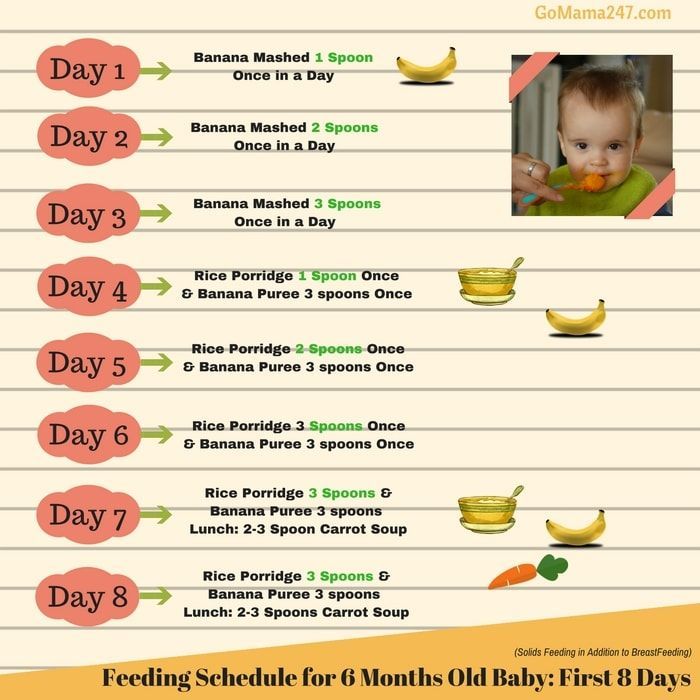 (It's best to avoid rice cereal, though.)
(It's best to avoid rice cereal, though.)
Fruit: Babies love the natural sweetness of fruits like pears, apples, berries, prunes, and stone fruits. Between 6 and 8 months, a baby will typically transition from about 2 to 3 tablespoons of fruit puree a day to 4 to 8 tablespoons (1/4 to 1/2 cup) of mashed or minced fruit.
Photo credit: Karla Martin for BabyCenter
Dinner for a younger baby (6 to 8 months)
If you serve a grain and fruit in the morning, consider offering a protein-rich food and vegetable later in the day. Your child may eat more or less than the amounts shown.
Protein: A baby might transition from eating 1 to 2 tablespoons of meat puree at 6 months to 2 to 4 tablespoons at 8 months, for example. Other good protein sources include cheese, unsweetened plain whole-milk yogurt, tofu, beans, and lentils.
Vegetables: Between 6 and 8 months, a baby will typically transition from about 2 to 3 tablespoons of vegetable puree a day to 4 to 8 tablespoons (1/4 to 1/2 cup).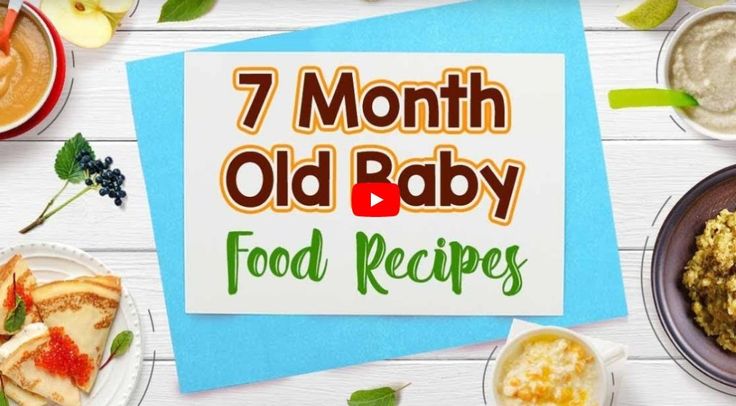 Try classic favorites like carrots, spinach, or butternut squash, as well as less traditional first foods such as parsnips, beets, or asparagus.
Try classic favorites like carrots, spinach, or butternut squash, as well as less traditional first foods such as parsnips, beets, or asparagus.
As your child's eating skills improve, gradually add more texture by dicing or mincing foods.
Photo credit: Karla Martin for BabyCenter
How much an 8- to 12-month-old should eat
By 8 months or so, your baby is likely getting the hang of eating and needs to eat more calories to support their growing body. But since their little belly can't hold a lot of food, they'll need to eat more often. Every baby is different, but this may be a good time to try offering a third solid food meal.
During this period:
- Continue to give your baby breast milk or formula.
- Add morning and afternoon snacks. (Some babies this age are happy with breast milk or formula as their snack, while others gravitate toward solid foods.) Once you've added a third meal and snacks, your baby will be eating or drinking something about every two to three hours.

- Continue to aim for a mix of proteins, vegetables, fruits, and grains.
- Introduce coarser and chunkier textures, for example, by dicing or mincing food instead of pureeing it, and graduate to soft finger foods as your baby's eating skills improve.
- Avoid foods with added sugars. Check the Nutrition Facts label on packaged foods, and try to steer clear of foods that list 1 gram or more of "Added Sugars."
- Provide healthy options, and let your baby choose how much to eat.
To visualize daily portions for an 8- to 12-month-old, check out the following photos of a typical day's menu for a baby this age, developed by the AAP.
Your child may eat more or less than these amounts. If you're concerned about how much your baby is eating, talk to their doctor for advice.
Photo credit: Karla Martin for BabyCenter
Breakfast for an older baby (8 to 12 months)
The AAP sample menu for a baby 8 to 12 months features a breakfast consisting of:
- 4 to 8 tablespoons (1/4 to 1/2 cup) whole-grain infant cereal mixed with formula or breast milk
- 4 to 8 tablespoons (1/4 to 1/2 cup) diced fruit
Note: This is an example. Your baby may eat different foods and amounts.
Your baby may eat different foods and amounts.
Photo credit: Karla Martin for BabyCenter
Morning snack for an older baby (8 to 12 months)
The AAP sample menu for a baby 8 to 12 months features a morning snack consisting of:
- 4 tablespoons (1/4 cup) diced cheese or cooked vegetables
Note: This is an example of a morning snack, which babies typically add sometime between 8 and 12 months. Your baby may eat different foods and amounts.
Photo credit: Karla Martin for BabyCenter
Lunch for an older baby (8 to 12 months)
The AAP sample menu for a baby 8 to 12 months features a lunch consisting of:
- 4 to 8 tablespoons (1/4 to 1/2 cup) unsweetened plain whole-milk yogurt or cottage cheese, or minced meat
- 4 to 8 tablespoons (1/4 to 1/2 cup) diced or mashed yellow or orange vegetable
Note: This is an example. Your baby may eat different foods and amounts.
Photo credit: Karla Martin for BabyCenter
Afternoon snack for an older baby (8 to 12 months)
The AAP sample menu for a baby 8 to 12 months features an afternoon snack consisting of:
- 4 tablespoons (1/4 cup) diced fruit or unsweetened plain whole-milk yogurt
- 1 whole-grain teething biscuit or cracker
Note: This is an example of an afternoon snack, which babies typically add sometime between 8 and 12 months. Your baby may eat different foods and amounts.
Your baby may eat different foods and amounts.
Photo credit: Karla Martin for BabyCenter
Dinner for older baby (8 to 12 months)
The AAP sample menu for a baby 8 to 12 months features a dinner consisting of:
- 4 tablespoons (1/4 cup) minced or ground poultry or meat, or diced tofu
- 4 to 8 tablespoons (1/4 to 1/2) cup diced, cooked green vegetable
- 4 tablespoons (1/4 cup) noodles, pasta, rice, or potato
- 4 tablespoons (1/4 cup) diced fruit
Note: This is an example. Your baby may eat different foods and amounts.
Photo credit: Karla Martin for BabyCenter
How much should my baby drink once they start eating solids?
Breast milk or formula will fully meet your child's hydration needs until they're about 6 months old. They may start drinking less as solid foods become a bigger part of their diet. Here are typical daily amounts by age – your baby's intake may be different, however.
6 to 8 months: 24 to 32 ounces of formula, or continued breastfeeding on demand
8 to 12 months: 24 ounces of formula, or continued breastfeeding on demand
Water: You can offer your baby water once they start eating solids, but let them self-regulate how much they drink. The Centers for Disease Control and Prevention (CDC) recommends giving babies who are 6 to 12 months old 4 to 6 ounces of water a day, but what your baby decides to drink may vary. They may drink more on a hot day, for example.
Avoid juice: Juice isn't recommended for babies younger than 12 months.
Photo credit: iStock.com / SDI Productions
Your baby has the final say
Keep in mind that these portions are an estimate. The truth is, every baby is different, and there's no set amount of food that's appropriate for every baby at every stage.
If you're worried about whether your baby is eating enough – or too much – the best advice is to look for and respond to signs that your baby is full.
Your baby's doctor will chart their weight gain at regular intervals. If the doctor sees a consistent growth curve and doesn't have other concerns, your baby is most likely eating the right amount of food.
Hungry for more?
Age-by-age guide to feeding your baby
The 10 best foods for babies
The worst foods for babies
Using spices and seasoning in baby food
Elizabeth Dougherty
Elizabeth Dougherty is a veteran parenting writer and editor who's been contributing to BabyCenter since 2015. She's an intrepid traveler, devoted yogi, and longtime resident of Silicon Valley, where she lives with her husband and son.
Advertisement | page continues below
Baby menu at 7 months: what is possible and what is not yet
- Anastasia Ivanovna, what are the nutritional features of children at 7 months?
- The menu for a baby at seven months is different from the menu for a newborn and a baby at one year old. This difference exists due to the fact that a number of body systems, including the gastrointestinal tract and oral cavity, have not yet been formed in a newborn, he is only learning to suck. From four to six months, the diet begins to include complementary foods - food that is different from breast milk or infant formula. In the year of the child, in ideal conditions, they are transferred to a common table.
This difference exists due to the fact that a number of body systems, including the gastrointestinal tract and oral cavity, have not yet been formed in a newborn, he is only learning to suck. From four to six months, the diet begins to include complementary foods - food that is different from breast milk or infant formula. In the year of the child, in ideal conditions, they are transferred to a common table.
Some pediatricians recommend introducing complementary foods from five to six months, sometimes even from four. But the enzymatic system of the baby's body has not yet been formed, so pedagogical complementary foods are possible at four or five months, and pediatric complementary foods by six months.
— How to combine breastfeeding or bottle feeding with complementary foods?
— Pediatricians and nutritionists recommend separating these meals and giving the main dairy food and complementary foods in separate meals so that the child understands what he is eating.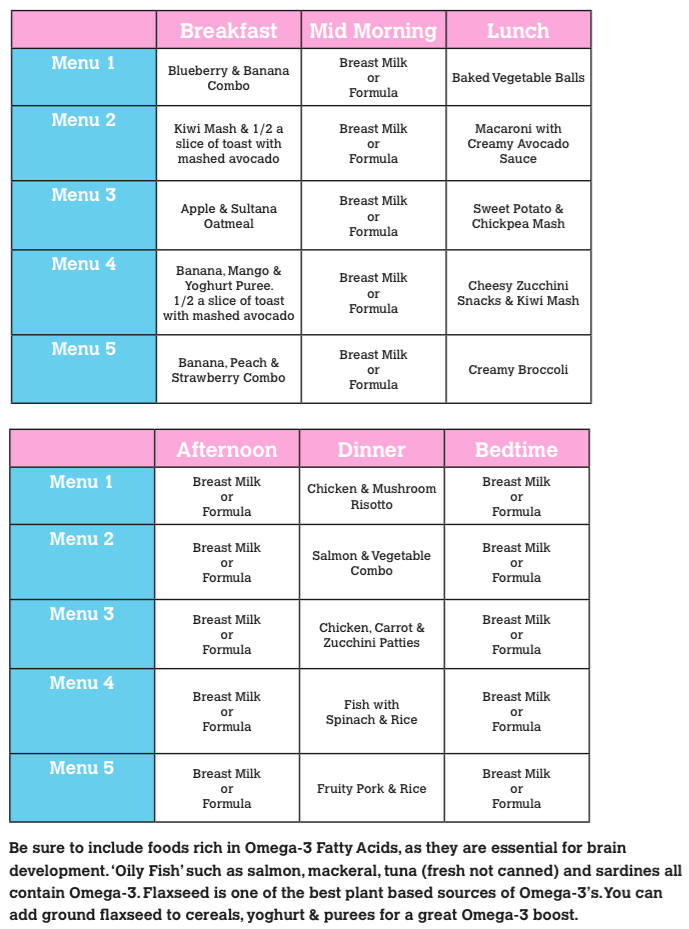
If complementary foods started at 4-5 months
— What rules of baby food should parents know?
— The functions of the gastrointestinal tract are formed in such a way that the body needs to adapt to the incoming products. With proper complementary foods, it is important to monitor the child's condition in the food diary and, if necessary, consult a doctor.
Basic feeding recommendations for seven-month-old babies
- One new product is given in small doses at the beginning of the day every four days to monitor for allergies, constipation, peeling and other reactions.
- One new food can be given per feeding.
- Water is best offered between feedings and not given with complementary foods.
- Do not force-feed: if the child refuses a certain dish, it can be offered at another time and in a different form.
- A child is not given unfamiliar food when he is not in a very good mood, teething, or has just been vaccinated.

— How to identify food allergies and find the allergen?
Observant mothers will see or hear the problem. The baby will have something on the body, constipation or indigestion will begin. A restless child will cry. To track the allergen, it is advisable to keep a food diary and keep your finger on the pulse. If there is a connection with the pediatrician, ask questions and, taking into account the vaccination calendar, the physiology of the development of your child, offer him certain products so as not to once again provoke an immune response.
What foods can be given at 7 months
Read also
- Why it is necessary to introduce meat complementary foods into the baby's diet and what foods can it be combined with.
— What purees and cereals can be given at 7 months?
- If this is the first complementary food for a baby, then monocomponent purees, dairy-free and milk porridges with one cereal in the composition are good: they are easier to digest and it is easier to track the body's reaction by them.
— In what order can complementary foods be given?
— If your baby is overweight by seven months, it is better to feed him vegetable puree. If everything is in order with weight, then preference can be given to cereals. All new products are introduced gradually: they begin to feed in the amount of 5-10 g, gradually increasing the volume to 50 g. By seven months, a portion of porridge at one time can reach up to 200 g. The third option for complementary foods, if parents want, can be fruit. It is in this sequence, because fruits are sweet, and the child does not always eat unleavened vegetables or cereals after them.
Each product will also have its own processing specifics:
- vegetables and fruits are given in the form of puree;
- purchased cereals are prepared according to the instructions;
- homemade porridges are boiled in water, then milk or a mixture is added if desired;
- cottage cheese is properly stored in the refrigerator, tracking the expiration date;
- dairy, vegetable broths are brought to a single consistency (mashed) so that the child develops the correct perception of the product.

— How many times to feed a child at 7 months and how much food to give?
- You need to focus on five feedings per day. If your baby cannot tolerate the interval between meals, it is worth supplementing with breast or formula after the introduction of complementary foods.
How to calculate complementary foods
A baby at seven months should weigh about eight kilograms. 1/8 of the child's weight is the daily amount of food, that is, approximately a kilogram of food, taking into account all feedings, or 200 grams per meal.
Sample menu for a 7-month-old baby (Russian Federation)
— At what age can semi-solid and solid foods be introduced into a child's diet?
- By 6 months, most babies are ready for a new food: the baby realizes that something is hard in his mouth. By the age of seven months, the skill of palmar grip is formed: the child is able to hold solid food in his hand, and he can be given biscuits and crackers to grind. Allergists and pediatricians consider 6-10 months as the optimal period to begin the introduction of semi-solid and solid foods. But if the swallowing apparatus is not formed, there may be problems with chewing and swallowing disorders up to the gag reflex.
By the age of seven months, the skill of palmar grip is formed: the child is able to hold solid food in his hand, and he can be given biscuits and crackers to grind. Allergists and pediatricians consider 6-10 months as the optimal period to begin the introduction of semi-solid and solid foods. But if the swallowing apparatus is not formed, there may be problems with chewing and swallowing disorders up to the gag reflex.
— What should parents do if their child refuses to eat? How to create food interest?
— It is necessary to understand the reasons for the baby's refusal to eat, among which may be: The pediatrician will track changes in health by analysis and, if necessary, adjust the diet.
At seven months, significant changes occur in the work of the gastrointestinal tract, the child actively shows interest in "adult" products, in new tastes. It will be easier for the baby to readjust if you choose products that will match his physiology and fully cover his needs for growth and communication. You need to carefully monitor the reaction of the body to each new product for 4-6 days.
You need to carefully monitor the reaction of the body to each new product for 4-6 days.
* Breast milk is the best food for babies. WHO recommends exclusive breastfeeding for the first 6 months of a child's life and continued breastfeeding after complementary foods are introduced until the age of 2 years. Before introducing new products into the baby's diet, you should consult with a specialist. The material is for informational purposes and cannot replace the advice of a healthcare professional. For feeding children from birth.
Diet for a 7-month-old child
When compiling a diet for a seven-month-old baby, distribute the products so that you get a certain prototype of the menu of an already grown-up child with breakfast and lunch.
At this age, the yolk of a boiled egg, a valuable source of fat, vitamin B12, A, phosphorus and selenium, is introduced into the child's diet. Chopped yolk can be added to porridge or vegetable puree.
At the age of 7 months, you can already give your baby a cracker (in the form of dried bread) and baby biscuits.
The volume of fruit puree and juice is increased to 70 g.
It is still better to give preference to commercially produced complementary foods, given their high degree of safety and variety. If the baby does not perceive a new product the first time, it can be mixed with an already familiar product.
Approximate diet for a 7 month old baby.
| I feeding 6 hours | Breastmilk or VHI* | 200 ml |
| II feeding 10 hours | Dairy-free or milk porridge ** Butter Boiled egg yolk Supplementation with breast milk or VHI | 150 g |
| III feeding 14 hours | Vegetable puree Vegetable oil Meat puree Fruit juice | 170 g about 1 tsp. 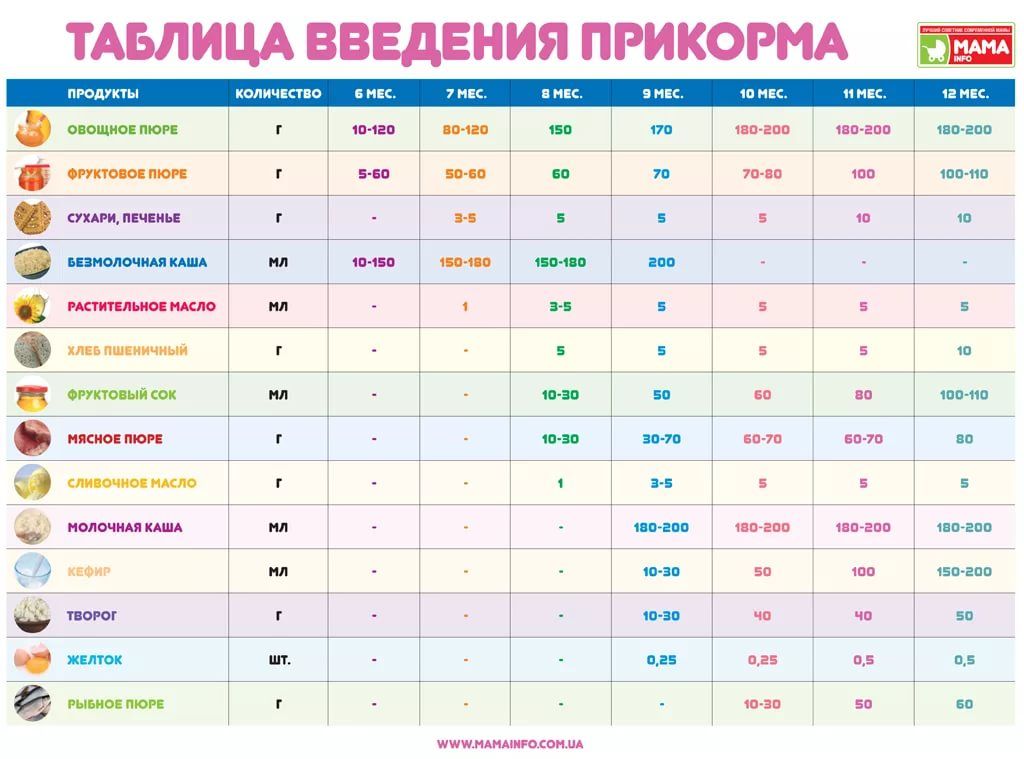 30 g 70 ml |
| IV feeding 18 hours | Fruit puree Baby biscuits Breast milk supplement or VHI | 70 g |
| V feeding 22 hours | Breast milk or VHI | 200 ml |
* - infant formula
** - dairy-free porridge should be diluted with breast milk or infant formula that the child receives. Milk porridge is diluted with water.
Approximate diet of a 7-month-old child with cow's milk protein allergy:
| I feeding 6 hours | Breast milk or formula for infants with intolerance to cow's milk proteins | 200 ml |
| II feeding 10 hours | Dairy-free porridge* Vegetable oil Fruit puree (apple, pear) | 130 g about 1 tsp. 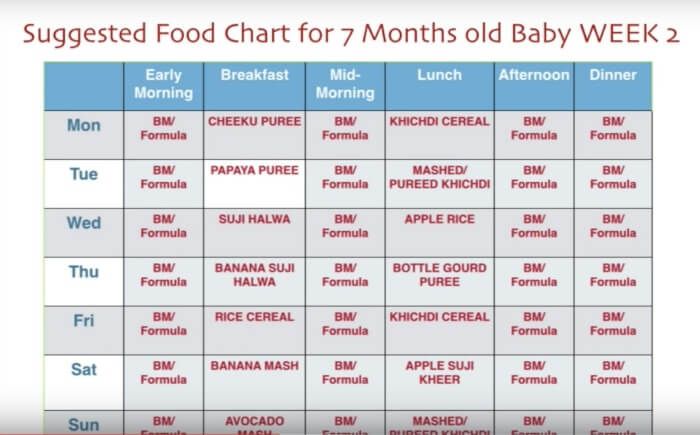 |



